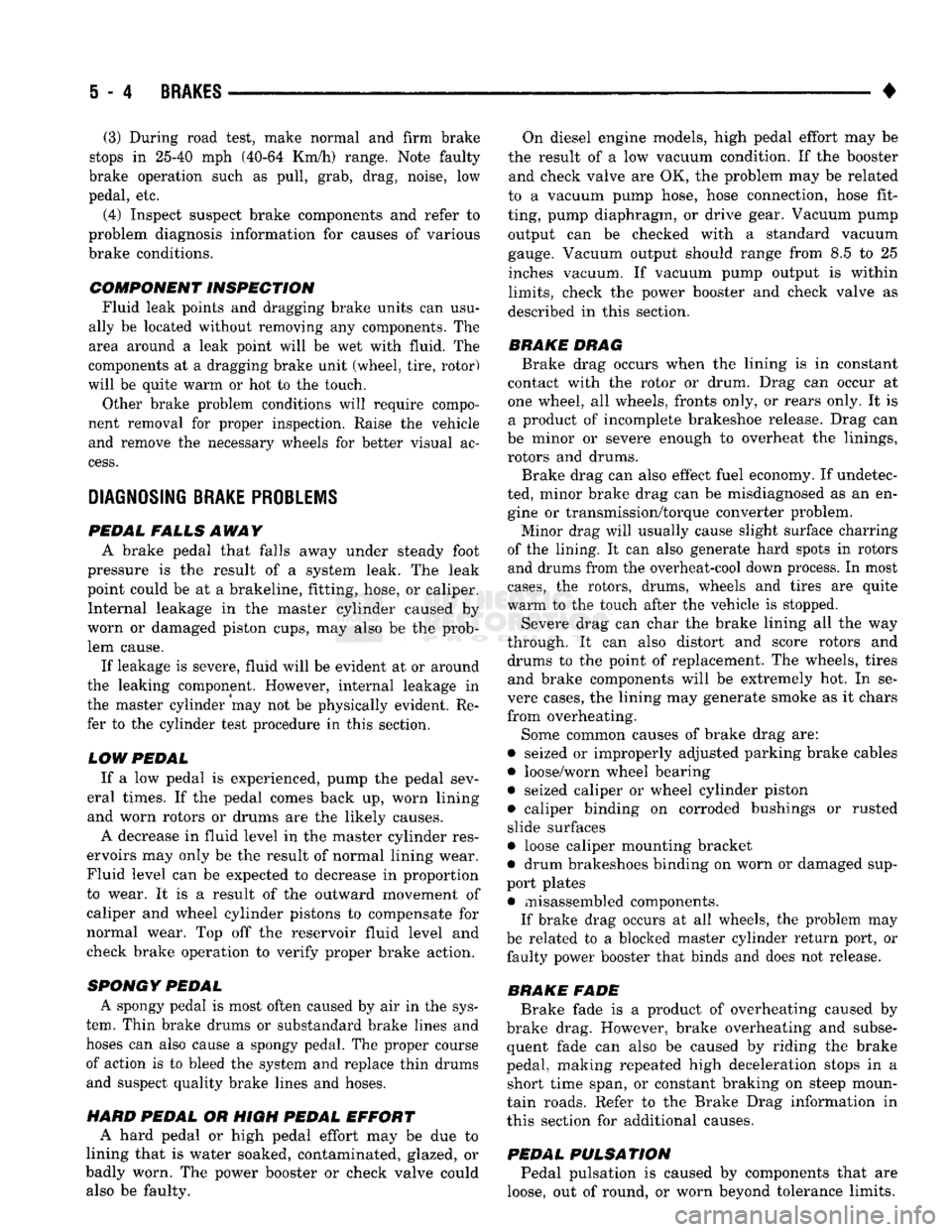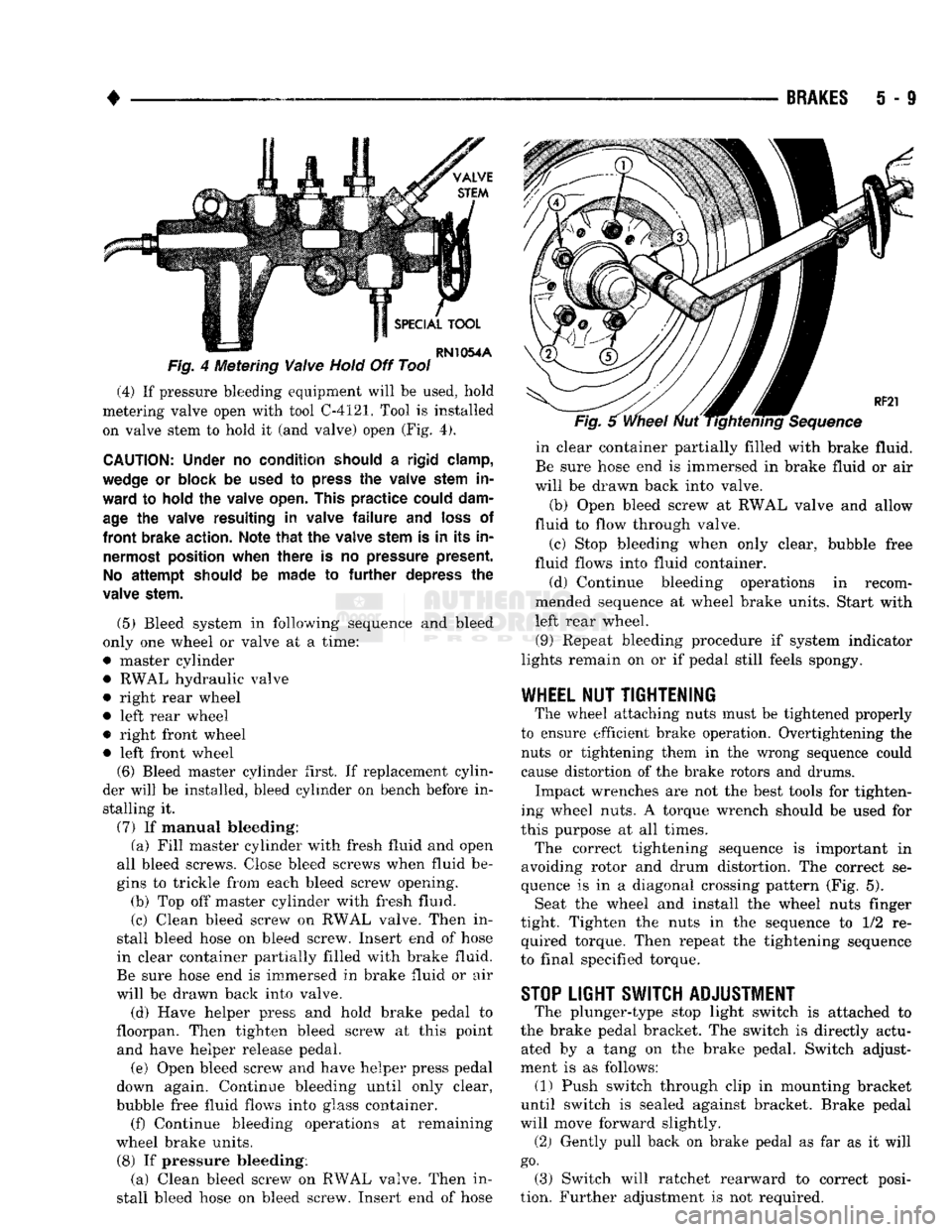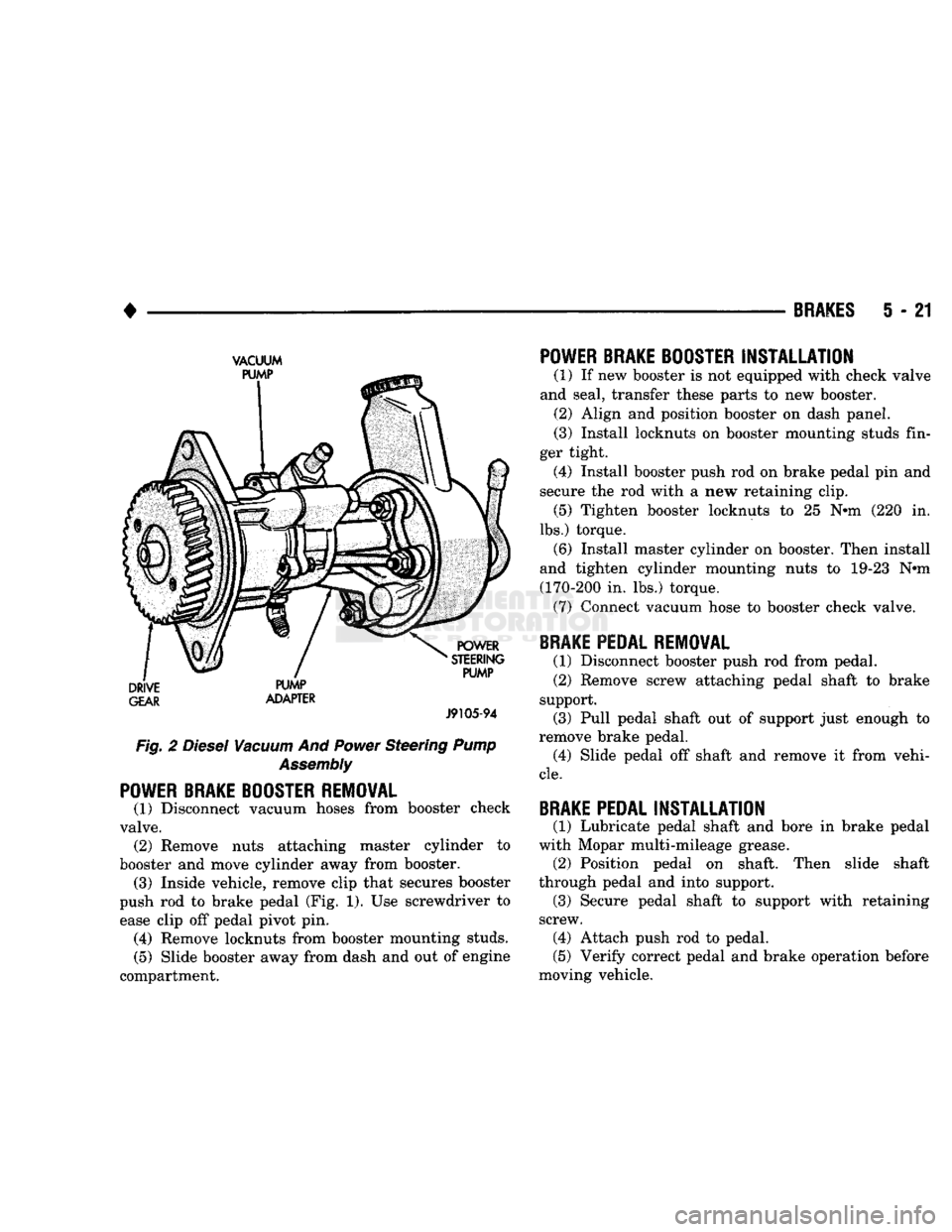1993 DODGE TRUCK torque
[x] Cancel search: torquePage 186 of 1502

REAR
SUSPENSION
AND
AXLE
3 - 59
TORQUE
SPECIFICATIONS
REAR
SUSPENSION
COMPONENTS 8 3/8 AND 9 1/4 INCH
AXLE
REAR
SUSPENSION
COMPONENTS
DESCRIPTION
TORQUE
Jounce Bumper to Bracket 20 N-m (180 in. lbs.)
Jounce Bumper/Bracket to Frame (Round) 41 N-m (30 ft. lbs.)
Jounce Bumper/Bracket to Frame (Block)......... 23 N-m (200 ft. lbs.)
Shock
Lower Nut 82 N-m (60 ft. lbs.)
Shock
Upper Nut 82 N-m (60 ft. lbs.)
Spring
Center Bolt 20 N-m (15 ft. lbs.)
Spring
U-Bolt Nut
(1/2-20)
88 N-m (65 ft. lbs.)
Spring
U-Bolt Nut
(9/16-18)
149 N-m (110 ft. lbs.)
Spring
Front and Rear Pivot Bolt/Nut
(1/2-20)
88 N-m (65 ft. lbs.)
Spring
Front and Rear Pivot Bolt/Nut(5/8-18).... 135 N-m
(100ft.
lbs.)
Spring
Front and Rear Pivot Bolt/Nut
(3/4-16)
183 N-m (135 ft. lbs.)
Spring
Pad to Frame (Aux) 41 N-m (30 ft. lbs.)
J9203-82
DESCRIPTION
TORQUE
8-3/8 Axle
Differential
Bearing Cap Bolt
9-1/4 Axle
Differential
Bearing Cap Bolt
Brake
Backing
Plate ,
Differential
Housing
Cover
Bolt
Pinion Yoke Nut (Minimum Torque)
Ring
Gear Bolt...
RWAL
Brake
Sensor
95 N*m (70 ft. lbs.)
136
N*m(100
ft. lbs.)
... 64 N*m (48 ft. lbs.)
47 N*m (35 ft. lbs.;
285Ntti
(210 ft. lbs.)
... 95 N*m (70 ft. lbs.) ... 24 N*m (18 ft. lbs.)
J9203-69
MODEL
60 AND 70
AXLE
REAR
AXLE
MODEL
60 and 70
DESCRIPTION
TORQUE
Axle Flange to Hub Bolts. Bearing Cap Bolts 95 N-m (70 ft. lbs.)
... 95 to 122 N-m (70 to 90 ft. lbs.)
Case
Half
Bolts
(Powr-Lok) ..
Case
Half
Bolts
Heavy Duty (Powr-Lok)
Differential
Cover Bolts
Fill
Hole Plug
Ring
Gear
Bolts
(Grade 8)
Ring
Gear
Bolts
(Grade 9)
RWAL
Brake
Sensor
89 to 94 N-m
(65 to 70 ft. lbs.)
122 to 136 N-m
(90 to 100 ft. lbs.)
47 N-m (35 ft. lbs.) 34 N-m (25 ft. lbs.) 136 to 163 N-m
(100 to 120 ft. lbs.) 169 to 183 N-m
(125 to 135 ft. lbs.)
24 N-m (18 ft. lbs.)
J9203-83
Page 191 of 1502

5
- 4
BRAKES
• (3) During road test, make normal and firm brake
stops in 25-40 mph (40-64 Km/h) range. Note faulty
brake operation such as pull, grab, drag, noise, low
pedal, etc.
(4) Inspect suspect brake components and refer to
problem diagnosis information for causes of various
brake conditions.
COMPONENT
INSPECTION
Fluid leak points and dragging brake units can usu
ally be located without removing any components. The
area around a leak point will be wet with fluid. The
components at a dragging brake unit (wheel, tire, rotor)
will be quite warm or hot to the touch.
Other brake problem conditions will require compo
nent removal for proper inspection. Raise the vehicle and remove the necessary wheels for better visual ac
cess.
DIAGNOSING BRAKE
PROBLEMS
PEDAL FALLS
AWAY
A
brake pedal that falls away under steady foot
pressure is the result of a system leak. The leak
point could be at a brakeline, fitting, hose, or caliper. Internal leakage in the master cylinder caused by
worn or damaged piston cups, may also be the prob lem cause.
If leakage is severe, fluid will be evident at or around
the leaking component. However, internal leakage in
the master cylinder may not be physically evident. Re fer to the cylinder test procedure in this section.
LOW PEDAL
If a low pedal is experienced, pump the pedal sev
eral times. If the pedal comes back up, worn lining
and worn rotors or drums are the likely causes.
A decrease in fluid level in the master cylinder res
ervoirs may only be the result of normal lining wear.
Fluid level can be expected to decrease in proportion to wear. It is a result of the outward movement of
caliper and wheel cylinder pistons to compensate for
normal wear. Top off the reservoir fluid level and
check brake operation to verify proper brake action.
SPONGY PEDAL. A spongy pedal is most often caused by air in the sys
tem. Thin brake drums or substandard brake lines and
hoses can also cause a spongy pedal. The proper course
of action is to bleed the system and replace thin drums and suspect quality brake lines and hoses.
HARD PEDAL
OR
HIGH
PEDAL
EFFORT
A hard pedal or high pedal effort may be due to
lining that is water soaked, contaminated, glazed, or
badly worn. The power booster or check valve could also be faulty. On diesel engine models, high pedal effort may be
the result of a low vacuum condition. If the booster and check valve are OK, the problem may be related
to a vacuum pump hose, hose connection, hose fit
ting, pump diaphragm, or drive gear. Vacuum pump output can be checked with a standard vacuum
gauge. Vacuum output should range from 8.5 to 25 inches vacuum. If vacuum pump output is within
limits,
check the power booster and check valve as
described in this section.
BRAKE DRAG
Brake drag occurs when the lining is in constant
contact with the rotor or drum. Drag can occur at
one wheel, all wheels, fronts only, or rears only. It is a product of incomplete brakeshoe release. Drag can
be minor or severe enough to overheat the linings,
rotors and drums.
Brake drag can also effect fuel economy. If undetec
ted, minor brake drag can be misdiagnosed as an en gine or transmission/torque converter problem.
Minor drag will usually cause slight surface charring
of the lining. It can also generate hard spots in rotors and drums from the overheat-cool down process. In most
cases,
the rotors, drums, wheels and tires are quite
warm to the touch after the vehicle is stopped.
Severe drag can char the brake lining all the way
through. It can also distort and score rotors and drums to the point of replacement. The wheels, tires and brake components will be extremely hot. In se
vere cases, the lining may generate smoke as it chars
from overheating.
Some common causes of brake drag are:
• seized or improperly adjusted parking brake cables
• loose/worn wheel bearing
• seized caliper or wheel cylinder piston
• caliper binding on corroded bushings or rusted
slide surfaces
• loose caliper mounting bracket
• drum brakeshoes binding on worn or damaged sup
port plates
• misassembled components. If brake drag occurs at all wheels, the problem may
be related to a blocked master cylinder return port, or faulty power booster that binds and does not release.
BRAKE FADE
Brake fade is a product of overheating caused by
brake drag. However, brake overheating and subse quent fade can also be caused by riding the brake
pedal, making repeated high deceleration stops in a short time span, or constant braking on steep moun
tain roads. Refer to the Brake Drag information in
this section for additional causes.
PEDAL
PULSA
TION
Pedal pulsation is caused by components that are
loose, out of round, or worn beyond tolerance limits.
Page 196 of 1502

BRAKES
i - 9
Fig.
4 Metering
Valve
Hold
Off Tool (4) If pressure bleeding equipment will be used, hold
metering valve open with tool C-4121. Tool is installed on valve stem to hold it (and valve) open (Fig. 4).
CAUTION:
Under
no
condition should
a
rigid clamp,
wedge
or
block
be
used
to
press
the
valve stem
in
ward
to
hold
the
valve open. This
practice
could dam
age
the
valve resulting
in
valve
failure and
loss
of
front
brake action. Note
that the
valve stem
is in its in
nermost position when
there
is no
pressure present.
No
attempt
should
be
made
to further
depress
the
valve stem.
(5) Bleed system in following sequence and bleed
only one wheel or valve at a time:
• master cylinder • RWAL hydraulic valve
• right rear wheel
• left rear wheel
• right front wheel • left front wheel (6) Bleed master cylinder first. If replacement cylin
der will be installed, bleed cylinder on bench before in stalling it.
(7) If manual bleeding: (a) Fill master cylinder with fresh fluid and open
all bleed screws. Close bleed screws when fluid be
gins to trickle from each bleed screw opening. (b) Top off master cylinder with fresh fluid.
(c) Clean bleed screw on RWAL valve. Then in
stall bleed hose on bleed screw. Insert end of hose
in clear container partially filled with brake fluid.
Be sure hose end is immersed in brake fluid or air
will be drawn back into valve.
(d) Have helper press and hold brake pedal to
floorpan. Then tighten bleed screw at this point and have helper release pedal.
(e) Open bleed screw and have helper press pedal
down again. Continue bleeding until only clear,
bubble free fluid flows into glass container. (f) Continue bleeding operations at remaining
wheel brake units.
(8) If pressure bleeding: (a) Clean bleed screw on RWAL valve. Then in
stall bleed hose on bleed screw. Insert end of hose in clear container partially filled with brake fluid.
Be sure hose end is immersed in brake fluid or air
will be drawn back into valve.
(b) Open bleed screw at RWAL valve and allow
fluid to flow through valve.
(c) Stop bleeding when only clear, bubble free
fluid flows into fluid container.
(d) Continue bleeding operations in recom
mended sequence at wheel brake units. Start with
left rear wheel.
(9) Repeat bleeding procedure if system indicator
lights remain on or if pedal still feels spongy.
WHEEL
NUT
TIGHTENING
The wheel attaching nuts must be tightened properly
to ensure efficient brake operation. Overtightening the nuts or tightening them in the wrong sequence could
cause distortion of the brake rotors and drums.
Impact wrenches are not the best tools for tighten
ing wheel nuts. A torque wrench should be used for
this purpose at all times.
The correct tightening sequence is important in
avoiding rotor and drum distortion. The correct se
quence is in a diagonal crossing pattern (Fig. 5). Seat the wheel and install the wheel nuts finger
tight. Tighten the nuts in the sequence to 1/2 re quired torque. Then repeat the tightening sequence
to final specified torque.
STOP
LIGHT SWITCH ADJUSTMENT
The plunger-type stop light switch is attached to
the brake pedal bracket. The switch is directly actu ated by a tang on the brake pedal. Switch adjust
ment is as follows: (1) Push switch through clip in mounting bracket
until switch is sealed against bracket. Brake pedal
will move forward slightly.
(2) Gently pull back on brake pedal as far as it will
go.
(3) Switch will ratchet rearward to correct posi
tion. Further adjustment is not required.
Page 201 of 1502

5
- 14
BRAKES
•
Fig. 8 Combinat
BRAKE LINE AND HOSE REPLACEMENT Factory replacement brake lines and hoses are rec
ommended to ensure quality, correct length and su
perior fatigue life. Care should be taken to make sure that brake line and hose mating surfaces are
Valve
Mounting
clean and free from nicks and burrs. Also remember
that right and left brake hoses are not interchange
able.
Use new copper seal washers at all caliper connec
tions (Fig. 9). Be sure brake line connections are
properly made (not cross threaded) and tightened to recommended torque.
Brake line routing, connections and tightening
ref
erence information is outlined in Figures 9 through
12.
Page 204 of 1502

TUBE ASSEMBLY MASTER
CYLINDER TO BRAKE
VALVE REAR (SECONDARY)
BRACKET
AND SHIELD
BRAKE
HOSE AND RWAL
SENSOR
WIRING LET.
TORQUE
LET. POUNDS NEWTON
METRES
x!^ 145 IN.
16
XX 35 FT.
47
170 IN. 19
100 IN.
11
125
IN.
14
BRAKE
VALVE TUBE
TO RIGHT FRONT
BRAKE
HOSE
VIEW IN DIRECTION OF ARROW A
SCREW
<§>
GASKET
8905-54
Fig. 11
Brake
Lines—Two-Wheel
Drive
Models
Page 205 of 1502

LET.
TORQUE
LET. POUNDS
NEWTON
METRES
145 IN. 16
125 IN. 14
100 IN. 11
170 IN. 19
SCREW
RIGHT
BRAKE
TUBE
RIGHT
BRAKE
TUBE
BRAKE HOSE BRAKE
VALVE
TUBE
TO
FRONT
BRAKE HOSE
VALVE
VIEW
IN
DIRECTION
OF
ARROW
B
ASSEMBLY
8905-55
Fig. 12 Brake Lines—Four-Wheel Drive Models
Page 207 of 1502

5
- 20
BRAKES
•
POWER BRAKE BOOSTER—BRAKE PEDAL
INDEX
page
Brake Pedal
Installation
21
Brake Pedal Removal
21
General
Information
.......................
20
page
Power Brake Booster
Installation
.............
21
Power Brake Booster Removal
21
GENERAL
INFORMATION
Power brakes
are
standard
on all AD
models.
A
single
or
dual diaphragm, vacuum power brake
booster
is
used. AD
and W150
models
are
equipped with
a
single
diaphragm booster unit
(Fig. 1). D and
W250/350
models
are
equipped with
a
dual diaphragm booster. The booster unit consists
of a
single housing
di
vided into separate chambers
by one or two
internal
diaphragms.
The
outer edge
of the
diaphragm
is se
cured
to the
housing. The booster push
rod,
which connects
the
booster
to
the brake pedal
and
master cylinder,
is
attached
to
the center
of the
diaphragm.
A
check valve
is
used
in
the booster outlet connected
to the
engine intake manifold. Power assist
is
produced
by a
combination
of
vac
uum
and
atmospheric pressure
to
boost brake assist. The power brake booster
is not a
repairable
component.
The
booster must
be
replaced
as an
assembly
if
diagnosis indicates
a
malfunction
has occurred.
AD models with
the
Cummins diesel engine
are
equipped with
a
dual diaphragm power brake
booster.
A
separate vacuum pump assembly supplies the vacuum needed
for
booster operation
(Fig. 2).
The diesel vacuum pump
and the
power steering
pump
are
combined into
a
single assembly. Both
pumps
are
operated
by a
drive gear pressed onto
the
vacuum pump shaft.
The
drive gear
is
operated
by
the camshaft gear. A suspended-type brake pedal
is
used
for all
appli
cations.
The
pedal
is
attached
to the
pedal support
bracket with
a
pivot shaft.
The
pedal, bolt
and
bush ings
are all
serviceable components.
RESERVOIR
PEDAL
SHAFT
RETAINER
SCREW
MASTER
CYLINDER
AND BOOSTER
ASSEMBLY <5>
I
RETAINER
CLIP
TIGHTENING
TORQUE
'A>
200
IN.-LBS.
(23 N-m)
¥>
35
IN.-LBS.
(4 N.m)
LOCKNUT
«
RK721
Fig.
1
Power
Brake
Booster
And
Pedal
Mounting
Page 208 of 1502

•
BRAKES
5 - 21
VACUUM
GEAR
ADAPTER
J9105-94
Fig. 2
Diesel
Vacuum
And
Power
Steering
Pump
Assembly
POWER BRAKE BOOSTER REMOVAL
(1) Disconnect vacuum hoses from booster check
valve. (2) Remove nuts attaching master cylinder to
booster and move cylinder away from booster. (3) Inside vehicle, remove clip that secures booster
push rod to brake pedal (Fig. 1). Use screwdriver to ease clip off pedal pivot pin. (4) Remove locknuts from booster mounting studs.
(5) Slide booster away from dash and out of engine
compartment.
POWER BRAKE BOOSTER
INSTALLATION
(1) If new booster is not equipped with check valve
and seal, transfer these parts to new booster. (2) Align and position booster on dash panel.
(3) Install locknuts on booster mounting studs fin
ger tight. (4) Install booster push rod on brake pedal pin and
secure the rod with a new retaining clip. (5) Tighten booster locknuts to 25 Nth (220 in.
lbs.) torque. (6) Install master cylinder on booster. Then install
and tighten cylinder mounting nuts to 19-23 Nnn
(170-200 in. lbs.) torque. (7) Connect vacuum hose to booster check valve.
BRAKE PEDAL REMOVAL
(1) Disconnect booster push rod from pedal. (2) Remove screw attaching pedal shaft to brake
support. (3) Pull pedal shaft out of support just enough to
remove brake pedal. (4) Slide pedal off shaft and remove it from vehi
cle.
BRAKE PEDAL
INSTALLATION
(1) Lubricate pedal shaft and bore in brake pedal
with Mopar multi-mileage grease. (2) Position pedal on shaft. Then slide shaft
through pedal and into support. (3) Secure pedal shaft to support with retaining
screw. (4) Attach push rod to pedal.
(5) Verify correct pedal and brake operation before
moving vehicle.